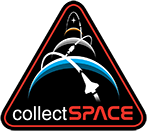|
|

|
|
Author
|
Topic: NASA's Artemis II mission (Orion/SLS)
|
Robert Pearlman
Editor Posts: 55523
From: Houston, TX
Registered: Nov 1999
|
 posted 05-01-2025 04:36 PM
posted 05-01-2025 04:36 PM
   
Lockheed Martin release Lockheed Martin Completes Orion Development for Artemis II Mission to the MoonUpgraded Spacecraft Delivered, Preparations for 2026 Launch Underway Lockheed Martin has completed assembly and testing of NASA's Orion Artemis II spacecraft, transferring possession to NASA's Exploration Ground Systems (EGS) team today. This milestone is a significant step for NASA and the Artemis industry team, as they prepare to launch a crew of four astronauts to further the agency's mission in establishing a human presence on the Moon for exploration and scientific discovery. It will also help build the foundation for the first crewed missions to Mars.  Above: The finished Orion spacecraft for the Artemis II mission was officially handed over to NASA for launch processing for crewed mission to the Moon early next year.
Orion is the most advanced, human-rated, deep space spacecraft ever developed. Lockheed Martin is the prime contractor to NASA for Orion and built the crew module, crew module adaptor and launch abort system.
"This achievement is a testament to our employees and suppliers who have worked tirelessly to get us to this important milestone," said Kirk Shireman, vice president of Human Space Exploration and Orion program manager at Lockheed Martin. "The Orion spacecraft completion for Artemis II is a major step forward in our nation's efforts to develop a long-term lunar presence. It's exciting to think that soon, humans will see the Earth rise over the lunar horizon from our vehicle, while also traveling farther from Earth than ever before."
Upgraded for Crew Onboard The uncrewed EFT-1 and Artemis I test flights were the first steps in validating the spacecraft's core systems. Artemis II will put Orion through its final tests in deep space with a crew on board and will include learnings and significant enhancements gleaned from the Artemis I mission.
To support the health and safety of the crew, new systems have been added, which include life support – air, water, thermal control, waste management – displays and controls, audio communications, an exercise machine and a fully functional Launch Abort System. Additionally, the vehicle is outfitted with a subset of docking sensors and an experimental laser communication system, enabling high data-rate communications and paving the way for future missions.
Path to Launch With the completion of Orion, the EGS team will perform final preparations on the spacecraft, readying it for launch. Orion will soon be moved from the Neil Armstrong Operations and Checkout Building at NASA's Kennedy Space Center to various processing facilities. This is where EGS will load propellants and other consumables, such as water and oxygen, and install the launch abort system and its protective fairings. Upon completion, it will then be transported to the Vehicle Assembly Building, lifted onto the Space Launch System (SLS) rocket and undergo final preparations for launch.
Historic Artemis Flight Scheduled to launch in early 2026, Artemis II and the Orion spacecraft will host NASA astronauts Reid Wiseman, Victor Glover, Christina Koch and Canadian astronaut Jeremy Hansen. Their 10-day journey will include flying 4,600 miles beyond the Moon and back to Earth.
During the mission, the crew will evaluate the spacecraft's performance, test its navigation and communication systems, and conduct a series of scientific experiments. They will perform a rendezvous operation with the SLS upper stage, practicing docking activities needed for future missions including Artemis III – which will mark the first human lunar landing since Apollo 17 in 1972.
With work on Orion for Artemis II completed, Lockheed Martin continues to develop and assemble Orion spacecraft for future Artemis missions. Artemis III and IV vehicles are in the Operations and Checkout Building, while the pressure vessel is being welded at NASA's Michoud Facility in New Orleans. Lockheed Martin is on contract to develop Orion spacecraft up to Artemis VIII and has decreased cost with each vehicle. |
Robert Pearlman
Editor Posts: 55523
From: Houston, TX
Registered: Nov 1999
|
 posted 08-04-2025 04:02 PM
posted 08-04-2025 04:02 PM
   
NASA release NASA’s Artemis Crew Trains in Moonbound Orion Ahead of MissionThe first crew slated to fly in NASA’s Orion spacecraft during the Artemis II mission around the Moon early next year entered their spacecraft for a multi-day training at the agency’s Kennedy Space Center in Florida. Crew donned their spacesuits July 31 and boarded Orion to train and experience some of the conditions they can expect on their mission. 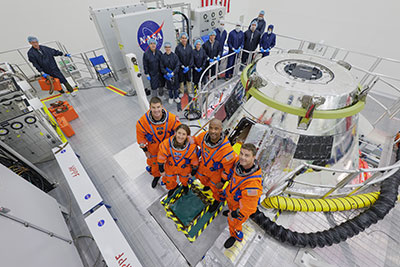 Above: The Artemis II crew (from left to right) CSA (Canadian Space Agency) Jeremy Hansen, mission specialist; Christina Koch, mission specialist; Victor Glover, pilot; and Reid Wiseman, commander, don their Orion Crew Survival System Suits for a multi-day crew module training beginning Thursday, July 31, 2025 at the agency’s Kennedy Space Center in Florida. Behind the crew, wearing clean room apparel, are members of the Artemis II closeout crew. (NASA/Rad Sinyak) NASA astronauts Reid Wiseman, Victor Glover, and Christina Koch, and CSA (Canadian Space Agency) astronaut Jeremy Hansen participated in a suited crew test and crew equipment interface test, performing launch day and simulated orbital activities inside Orion. “In about six months, Artemis II astronauts will journey around the Moon for the first time in 53 years,” Duffy said. “America rallied behind Apollo because it represented the best of us – now it’s Artemis’ turn. They’re not just carrying a flag – they’re carrying the pride, power, and promise of the United States of America.” With Orion powered on, the suited crew test was a close representation of what the crew can expect on launch day. The crew began the day by suiting up inside the spaceport’s Multi-Operation Support Building, donning their Orion crew survival system spacesuits, boarding the zero-emission crew transportation vehicles, and entering Orion, which is currently inside the Multi-Payload Processing Facility, where engineers have loaded its propellants over the course of several weeks. Once in Orion, the crew performed several launch day activities, including communications checkouts and suit leak checks. For the first time, the crew was connected to the spacecraft and its communications and life control systems, and all umbilicals were connected while the spacecraft operated on full power. Teams simulated several different ground and flight conditions to give the crew more experience managing them in real time. Some of the activities simulated scenarios where the crew was challenged to address potential issues while in space such as leaks and failure of the air revitalization system fan, which is needed to provide oxygen and remove carbon dioxide from the cabin. Getting this hands-on experience and learning how to act fast to overcome potential challenges during flight helps ensure the crew is ready for any scenario. The test provides astronauts the ability to train on the actual hardware they will use during flight, allowing them and support teams the opportunity to familiarize themselves with the equipment in configurations very close to what will be experienced during flight. It also allows teams to verify compatibility between the equipment and systems with flight controller procedures, so they can make any final adjustments ahead of launch. “It signifies the immense amount of work that our operations and development teams put into making sure we are ready for launch.” Quinn said. “They have meticulously planned each operation, timing them to perfection – and now we put it to the test.” Exchanging their spacesuits for cleanroom garments for the crew equipment interface test, and with the spacecraft powered off, the crew also performed many of the activities they are likely to do in flight and conducted additional equipment checks. The crew practiced removing and stowing the foot pans on the pilot and commander seats, which will allow them to have more open space in the cabin after launch. They also accessed the stowage lockers and familiarized themselves with cameras, associated cables and mounts, and the environmental control and life support system hardware. In addition to getting practical experience with the actual hardware they’ll use in space, they also prepared for life in deep space, reviewing cabin labels, sleep arrangements and checklists, and the hygiene bay. |
Robert Pearlman
Editor Posts: 55523
From: Houston, TX
Registered: Nov 1999
|
 posted 08-11-2025 06:37 PM
posted 08-11-2025 06:37 PM
   
NASA release NASA's Artemis II Orion Spacecraft Moves Closer to LaunchNASA's Artemis II Orion spacecraft completed a short but important journey Aug. 10, at the agency's Kennedy Space Center in Florida. With spacecraft fueling complete, technicians moved Orion to the next facility on its path to the launch pad. 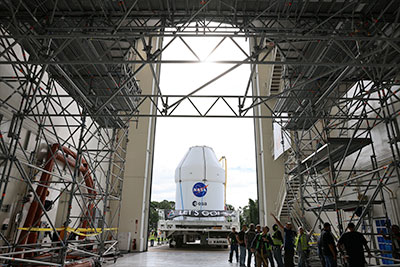 Above: NASA’s Artemis II Orion spacecraft arrives at the Launch Abort System Facility at the agency’s Kennedy Space Center in Florida on Sunday, Aug. 10, 2025, to prepare for integration with its 44-foot-tall launch abort system. (NASA/Kim Shiflett)
Teams transported Orion from Kennedy's Multi-Payload Processing Facility (MPPF) where it has been loaded with propellants for flight, to the Launch Abort System Facility (LASF). There, engineers with NASA's Exploration Ground Systems Program will integrate the escape system atop the crew module. Orion arrived to the MPPF in May, where technicians fueled and processed Orion, loading propellants, high pressure gases, coolant, and other fluids necessary for the spacecraft and crew to carry out their 10-day journey around the Moon and back. The Artemis II crew also took part in multiple days of tests inside Orion in the MPPF, donning their Orion Crew Survival System spacesuits and entering their spacecraft to test all the equipment interfaces they will operate during the mission. Now inside the LASF, Orion will be integrated with its 44-foot-tall launch abort system, made up of two segments: the launch abort tower, including the abort, jettison, and attitude control motors; and the fairing assembly, including the ogive panels that protect the crew module and provide aerodynamic support during launch. The system is designed to carry the crew to safety in the event of an emergency atop the SLS (Space Launch System) rocket. Once integration is completed, the entire Orion stack will be transported to High Bay 3 in NASA Kennedy's Vehicle Assembly Building where it will be connected to its Moon rocket. |
Robert Pearlman
Editor Posts: 55523
From: Houston, TX
Registered: Nov 1999
|
 posted 09-24-2025 04:45 PM
posted 09-24-2025 04:45 PM
   
collectSPACE Introducing Integrity: Artemis II astronauts name their Orion ride to moonThe first astronauts set to fly to the moon in more than 50 years will do so in Integrity. NASA's Artemis II crew revealed "Integrity" as the name of their Orion spacecraft during a news conference on Wednesday (Sept. 24) at the Johnson Space Center in Houston. 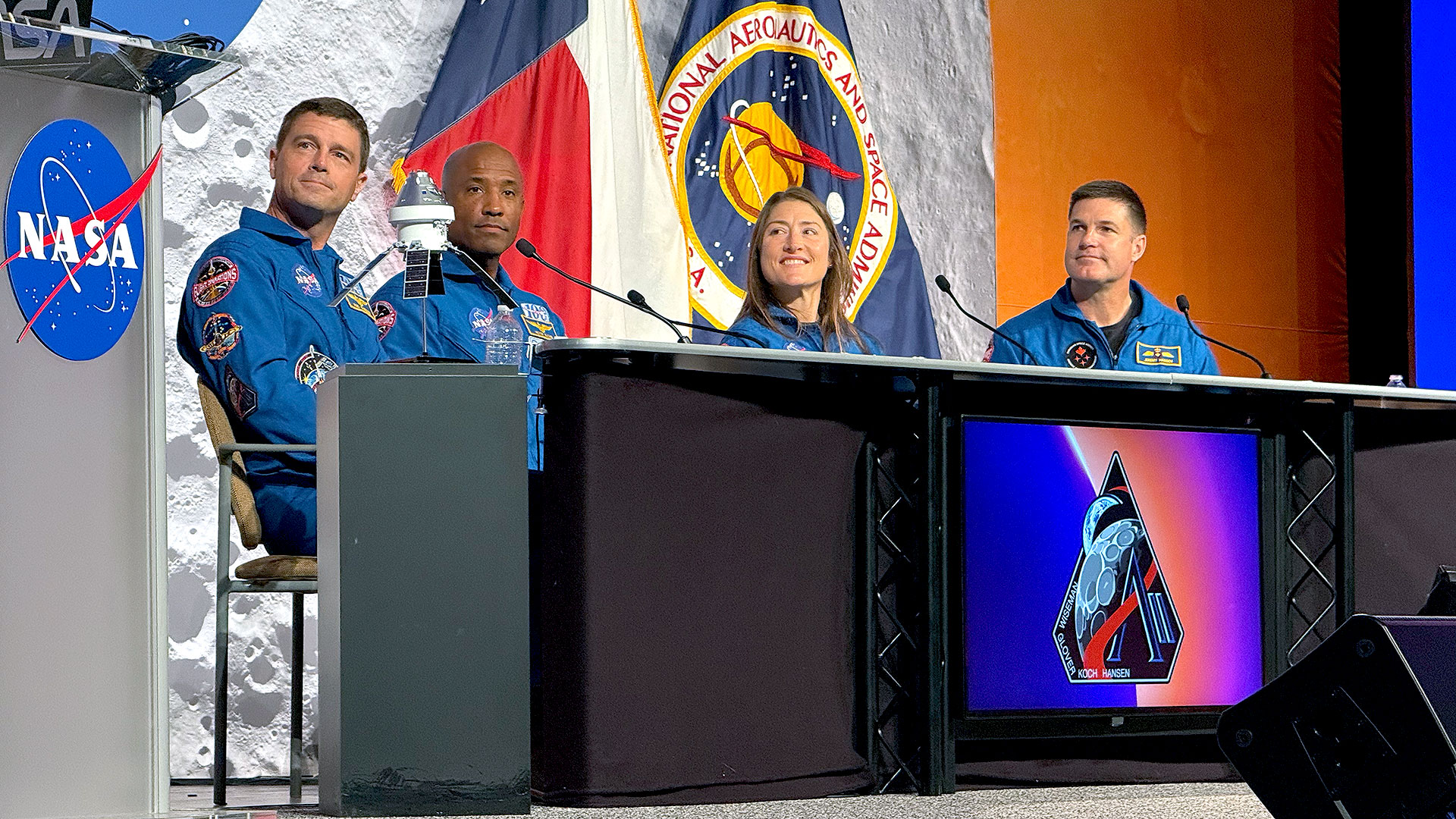 |
Robert Pearlman
Editor Posts: 55523
From: Houston, TX
Registered: Nov 1999
|
 posted 09-30-2025 06:20 PM
posted 09-30-2025 06:20 PM
   
NASA release NASA Draws Closer to Artemis II Rocket Completion with Newest AdditionNASA integrated the Artemis II Orion stage adapter with the rest of the SLS (Space Launch System) rocket on Sept. 24 in the Vehicle Assembly Building at the agency’s Kennedy Space Center in Florida. 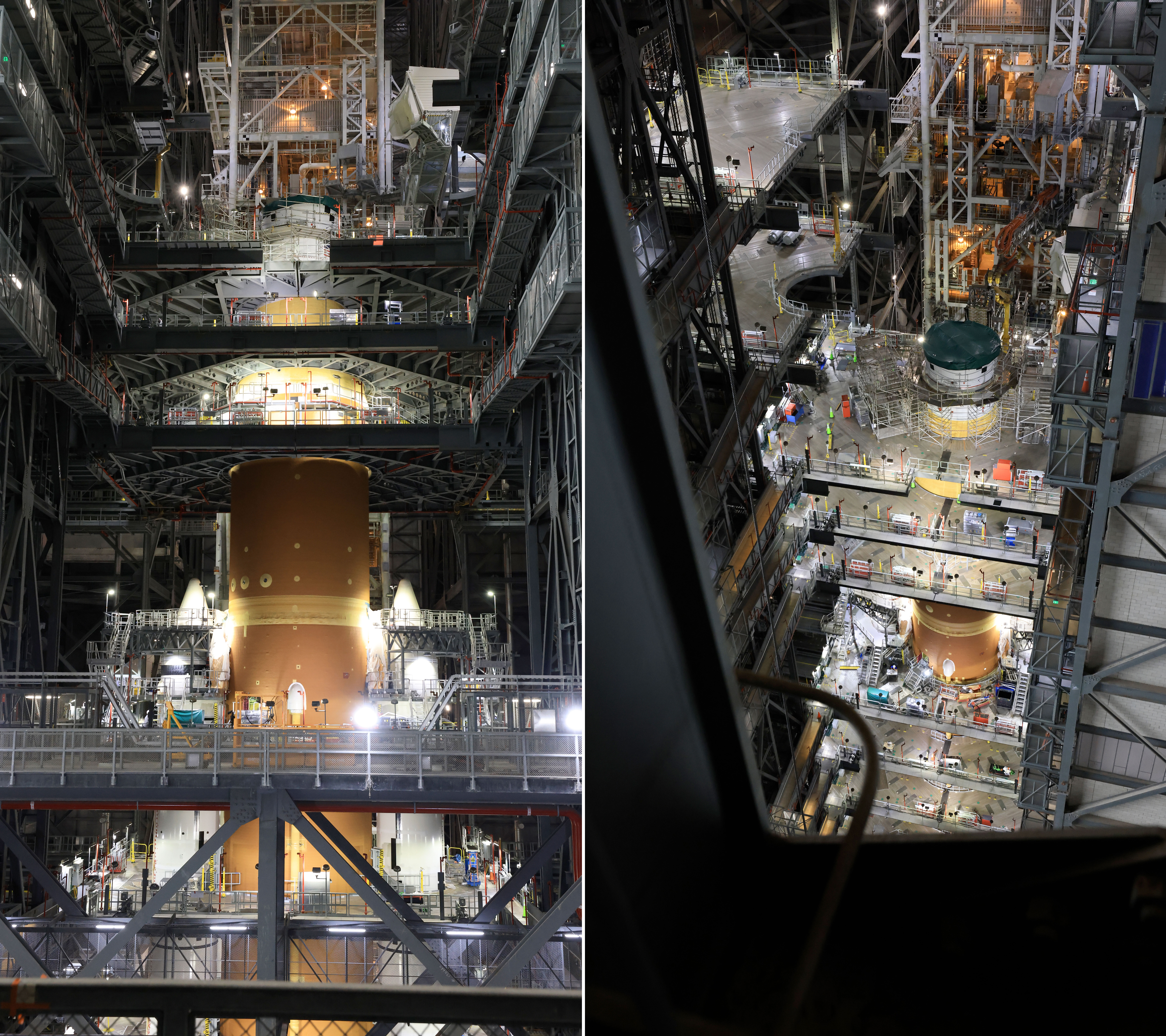 The Orion stage adapter connects the upper stage to the Orion spacecraft, isolates the spacecraft from hazardous gases, deploys small science satellites, and will be used in a maneuvering test during the Artemis II mission. (NASA)
Built by NASA engineers at the agency’s Marshall Space Flight Center in Huntsville, Alabama, the adapter connects the rocket’s interim cryogenic propulsion stage to the Orion spacecraft. A composite diaphragm within the ring protects the Orion spacecraft from hazardous gases generated during launch. Four CubeSats containing science and technology experiments will be deployed from the adapter into high Earth orbit after Orion is a safe distance away . The 12U CubeSats aboard Artemis II were developed by international partners South Korea, Germany, Argentina, and Saudi Arabia. One “U”, or unit, is defined as 10 centimeters by 10 centimeters by 10 centimeters. NASA will integrate the Orion spacecraft with the rocket in the coming weeks ahead of the mission, scheduled for no later than April 2026. Testing and simulations in preparation for the upcoming launch taking place no later than April 2026. As the Artemis II rocket is nearing completion at NASA Kennedy, work continues on flight hardware for Artemis III. NASA Marshall engineers have flipped the Artemis III Orion stage adapter to begin bracket, avionics, and cable instillation. Later this fall, its diaphragm will be installed. |
Robert Pearlman
Editor Posts: 55523
From: Houston, TX
Registered: Nov 1999
|
 posted 10-19-2025 10:33 AM
posted 10-19-2025 10:33 AM
   
Last stop before launch pad: Orion arrives at VABThe Artemis II Orion ("Integrity") on Thursday (Oct. 16) was rolled over to the Vehicle Assembly Building (VAB) at the Kennedy Space Center in preparation for its stacking atop the Space Launch System (SLS) rocket. "This step brings Artemis II closer to its historic launch in 2026, paving the way for America's return to the Moon!" said acting NASA Administrator Sean Duffy. The spacecraft had previously been in the Launch Abort System Facility, where it was fitted with its escape tower and ogive panels. Once mated with the SLS, the launch vehicle will be complete. The next milestone will be a countdown rehearsal in the VAB with the Artemis II crew. 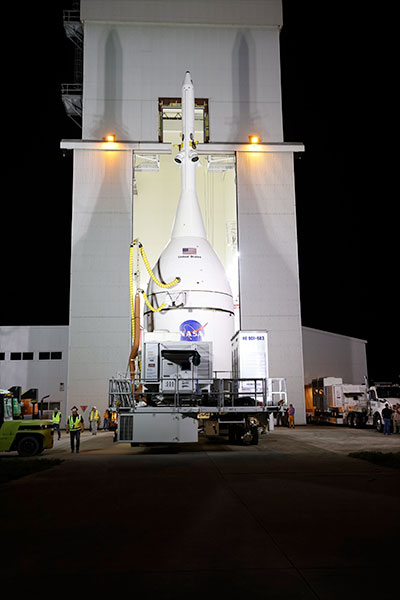 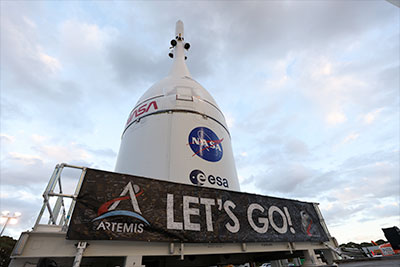
|
Robert Pearlman
Editor Posts: 55523
From: Houston, TX
Registered: Nov 1999
|
 posted 10-21-2025 12:28 PM
posted 10-21-2025 12:28 PM
   
'Integrity' integrated atop SLS rocketThe Artemis II Orion "Integrity" has been mounted atop its launch vehicle, the Space Launch System (SLS) rocket. "The last major hardware component before Artemis II launches early next year has been installed," said acting NASA Administrator Sean Duffy. "'Integrity' is our Orion spacecraft that will hold the Artemis II astronauts on their trip around the Moon. It's now fully attached to the Space Launch System and we are one step closer to mission launch! The next major milestone will be a countdown rehearsal in the VAB with the Artemis II crew. 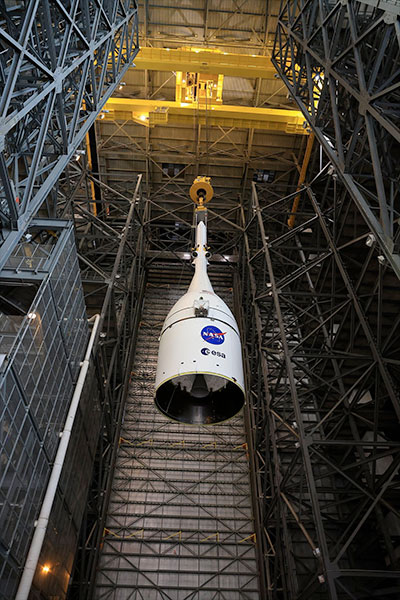 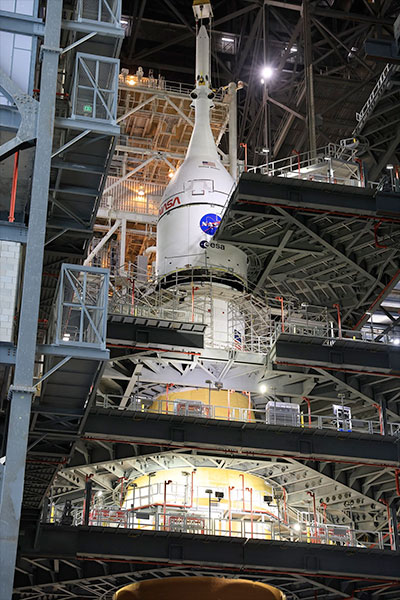
| |
Contact Us | The Source for Space History & Artifacts
Copyright 1999-2025 collectSPACE. All rights reserved.

Ultimate Bulletin Board 5.47a
|
|

|
 advertisement advertisement

|
